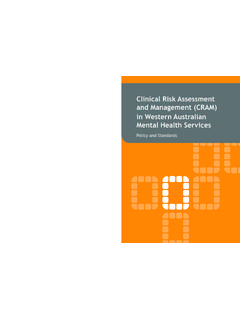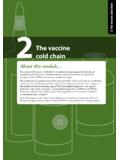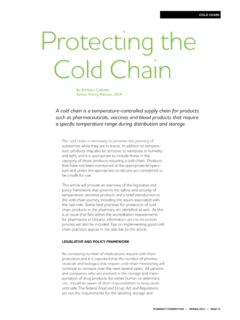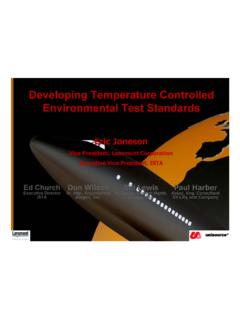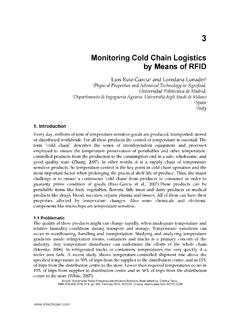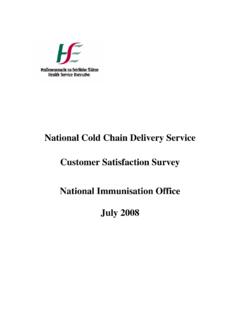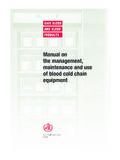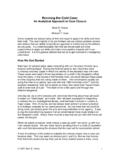Transcription of 1. Scope 2. The cold chain - WA Health
1 Vaccine cold chain Guidelines 2 1. Scope This document contains policies and guidelines that apply to all Western Australian (WA) Public and Community Health Services providing immunisation services in WA. 2. The cold chain The cold chain is a system of transporting and storing vaccines within a recommended temperature range of +2 to +8 degrees Celsius ( C). This temperature range has been selected by the World Health Organization (WHO), and adopted by the Australian Technical Advisory Group on Immunisation (ATAGI) for the National Immunisation Program (NIP), as a guide to protect vaccines against loss of vaccine potency due to excessive cold or heat1. The Communicable Disease Control Directorate (CDCD), Department of Health , Western Australia, is committed to best practice standards in the shipment, storage and administration of vaccines.
2 The recommended standards outlined in this policy document are drawn from the current edition of the Australian Immunisation Handbook2, the National Vaccine Storage Guidelines Strive for Five (2005)3 and the current Western Australian Drugs and Poisons Regulations4. For further information on maintaining the cold chain process, consult these publications. Every immunisation service provider (ISP) should have access to a copy of the current edition of the Australian Immunisation Handbook2, along with the National Vaccine Storage Guidelines - Strive for Five3, the cold chain Action Plan and the Daily Vaccine Fridge Temperature Recordings Calendar (all on-line at: ). These documents should be referred to for best practice guidelines. The Australian Government provides Western Australia with over $30 million of vaccines under the NIP.
3 It is the responsibility of CDCD, Child and Adolescent Community Health (CACH), the public Health units (PHU) and all ISPs to monitor, review and implement the processes in place to maintain the efficacy of these vaccines and minimise wastage. 3. Recommendations for monitoring and maintaining the cold chain process WA ISPs are required to adopt and adhere to the recommendations set out below for monitoring and maintaining the cold chain process. Vaccines during transport The WA Department of Health contracts a commercial logistics company to distribute vaccines around the State from a central distribution warehouse based in Perth. In the metropolitan area vaccine shipments are made directly from the State Distribution Centre to ISPs. In regional areas, the State Distribution Centre ships vaccines to the regional pharmacies who act as Regional Distribution Centres by on-forwarding vaccines to ISPs within their region.
4 Vaccines should be transported in refrigerated, temperature-monitored vehicles or in portable insulated containers (eskies) in order to maintain vaccine immunogenicity as described in the National Vaccine Storage Guidelines Strive for Five3. When using eskies to transport vaccines, eskies must be packed and ice bricks sweated according to National Vaccine Storage Guidelines Strive for Five3. Vaccine cold chain Guidelines 3 The State Distribution Centres must use cold chain monitors or data loggers when transporting vaccines, as recommended in the National Vaccine Storage Guidelines Strive for Regional Distribution Centres should use cold chain monitors, minimum/maximum thermometers or data loggers when sending vaccines to ISPs in their regions, as recommended in the National Vaccine Storage Guidelines Strive for Five3.
5 Out-reach clinics should use minimum/maximum thermometers, data loggers or cold chain monitors when transporting vaccines in eskies. On receipt of vaccine shipments, ISPs should check the cold chain monitor to ensure the vaccines are within the +2 to +8 C range. In the metropolitan area, if the cold chain monitor indicates the vaccines fall outside this range, the delivery should be refused and the State Distribution Centre should be informed immediately. In regional areas, if vaccines fall outside the +2 to +8 C range during forward transportation from the Regional Distribution Centre, the Regional Distribution Centre must be informed of the breach and the regional immunisation coordinator (RIC) should be contacted for advice on the efficacy of the vaccines.
6 Vaccines in the refrigerator Where possible, vaccines should be stored in a vaccine-specific refrigerator. Bar fridges are unsuitable for storing vaccines and cyclic defrost fridges are not recommended. The refrigerator temperature should be checked and recorded twice daily on the Daily Vaccine Fridge Temperature Recordings Calendar (available from the Public Health website ). Notable changes in temperature ranges should be discussed with your RIC. Accurate determination of the refrigerator temperature is important as deviations outside the recommended +2 to +8 C range can affect the efficacy of vaccines. ISPs are strongly encouraged to have a data logger installed in their vaccine refrigerator. Data from the data logger should be downloaded and reviewed weekly.
7 A back-up minimum/maximum thermometer or data logger in the refrigerator is recommended. This will enable the refrigerator temperature to be assessed in the event of a power outage that may result in reduced vaccine wastage. In addition, a back-up thermometer or data logger provides an alternate reading in case of battery or technical failure of your primary thermometer. In unusual circumstances where vaccines are stored in refrigerators in buildings which are not accessed daily, data loggers must be installed and they need to be read weekly. Minimal vaccine stocks should be stored in refrigerators that are not regularly accessed. Vaccine management Vaccine management is the responsibility of all staff. It is important that more than one staff member is educated on how to appropriately store vaccines, read and record daily refrigerator temperatures and reset data loggers and vaccine refrigerator monitors.
8 Management of a new vaccine refrigerator All newly installed vaccine refrigerators need to be monitored continuously with a data logger for at least 48 hours prior to use to ensure the refrigerator has a stable reading within the recommended range of +2 to +8 C. Vaccine cold chain Guidelines 4 Ongoing management of a vaccine refrigerator To ensure optimal functionality, the vaccine refrigerator should be continuously monitored for 48 hours with a data logger at least once annually. If the refrigerator cannot maintain a temperature range of +2 to +8 C it should be serviced or decommissioned. Vaccine refrigerators should be serviced as per the manufacturer s guidelines. Documentation of the service should be retained by the provider. Vaccine management is considered a key performance indicator for GP accreditation.
9 Records of daily temperature readouts, weekly data logger readouts and annual refrigerator audits should be kept for accreditation purposes. Ordering vaccines Government-procured vaccines can be ordered from CDCD via the on-line ordering website ( ). Those without internet access may order by fax on 9388 4877. A vaccine order form can be obtained from the Public Health website at: When placing a vaccine order, stock on hand ( the vaccines currently in the ISPs refrigerator) must be recorded in the appropriate column of the ordering sheet. This is a compulsory field and without this information the order cannot be processed. On receiving new stock, ensure vaccines closest to expiration are stored at the front of the refrigerator. Vaccines that have passed the expiry date need to be disposed of and the wastage reported to the RIC using the Vaccine Wastage Report Form (Appendix C, and on-line at: ).
10 Order and maintain appropriate levels of stock to meet the needs of clinic/practice while ensuring the refrigerator is not overcrowded. Stockpiling large quantities of vaccines is strongly discouraged as this poses a greater risk of substantial loss in the event of a refrigerator failure or power outage. A vaccine storage self-audit should be undertaken by the clinic/practice every six months, as recommended in the National Vaccine Storage Guidelines Strive for Five3. An audit template is included in Appendix 1 of the Strive for Five document which can be downloaded from: 4. cold chain breach The cold chain is a shared responsibility that begins from the time the vaccine is manufactured, and ends when the vaccine is administered to the recipient. A cold chain breach (CCB) occurs when the temperature falls outside of the recommended +2 to +8 C temperature range at any point during the cold chain process.







